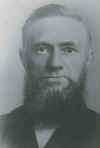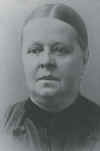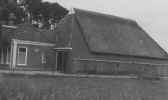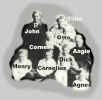|
by Henry Slotemaker Part Two---America
The family arrived in Orange City, Iowa sometime
in the spring or summer of 1881.1 Details of the problems and
difficulties of adjusting to the new environment and way of life have
either never been related in my presence, or they have been forgotten
and They purchased a small acreage, perhaps 20-40 acres with buildings about a mile from Orange City. On this the family settled and lived for 19 years. Jan (after this referred to as Dad) attended the town school when it opened in September. The only interesting and amusing thing that I can remember Dad telling about school is that in the classroom the English language was used, but on the playground the language was Dutch. Grandpa soon realized that there was a big difference between the farming methods of the Netherlands and Northwest Iowa. Instead of the highly intensified dairying and vegetable production he found beef cattle, hogs, corn and small grain. A few miles from town were still areas of virgin prairie. Each farm had a few non-descript dairy cows and a small flock of chickens to supply butter, milk and eggs, with a little to spare to exchange for groceries. To much of this, Grandpa’s reaction was: there must be a better way, and stirred by his adventurous spirit, he decided to do something about it. Something he also missed was the market days. Days when farmers took their produce to market, and buyers from near and far would be present. As he was an experienced cheese maker he decided to investigate the prospect of success in the operation of a cheese factory. It also occurred to him that this could lead to a farmers market. He would auction his cheese, and others would be invited to bring produce which he could auction off for them, as was common practice in the Netherlands. So the cheese factory was started.2 I do not know to what extent it was successful, but it didn’t last long. Various factors contributed. In the summer much of the milk was sour when it arrived at the factory, in winter it was frozen. Good quality was impossible to maintain, hence marketing was difficult. Yet it demonstrated his philosophy: "If you don’t want to be a victim of your environment, do something about it." Though he failed in this venture he was not defeated. He must have had some knowledge of the making of clay bricks in the Netherlands. Perhaps he had seen how adobe buildings were made in the Midwest. At least he apparently thought that the good Iowa clay was good for more things that raising corn and hogs. The few references that both Grandpa and Dad made to the brick factory were not enough to get a fair idea as to the measure of success they had with this project. I rather think it didn’t last long. There was something about the clay that caused them to crack or crumble. It seems that this second venture fared no better, perhaps worse than the first. In the meantime the family had grown up. At the age of 20 Anna married a native Iowan by the name of Henry Spaan. During the worst snow storm of Iowa’s history on Jan. 12, 1888, she gave birth to her first born who was named Cornelia. While in a general way I am following a chronological sequence in recording events, occasional departures are unavoidable. The great westward move in the nation was in
progress. Continued immigration from Europe contributed much to this
move. The influence of this was also felt in About eight years after their arrival in Orange
City, a Dutch immigrant family, Mr. And Mrs. Hendrik Kramer and five
daughters: Nellie, Ella, Tillie, Kate and Dora,
and two sons: Theodore
and Martin moved onto the small farm adjoining the Slotemaker place.
Another son, Henry Jr. was born to them in America. I know little of
the circumstances that led to their emigration to America. Kramer was
a To say that making the adjustment from small town clothing merchant in the Netherlands to operating a small farm in Iowa was difficult is an understatement. I do not know how many years elapsed from the time the Slotemaker family arrived in Orange City until the time when the cheese factory and the brick factory projects had transpired and expired. Dad had in the meantime grown from boyhood to young manhood. The small farm on which they lived could not keep both Grandpa and him occupied. So Dad found employment elsewhere, and Grandpa operated the farm making use of his experience with vegetables in the old country. As is common in rural communities, neighbors
contribute much to one another's welfare and happiness. This
neighborly relationship soon developed and grew in the Slotemaker and
Kramer families. Dad never said anything about blurring vision or
confused emotions when entering the Kramer home and confronting the
five sisters. Let it suffice to say that one of them held a special
attraction for him, and one was all that mattered, especially
when it was soon evident that the attraction was mutual. The fact that
both families held the same religious convictions contributed much to
their compatibility. It was perhaps also at this t As a teen-ager mother found employment in the home of the community doctor, Dr. DeBei. As the doctor had his office in the home, mother was often called upon to help him with treating patients, including minor surgery such as setting broken bones, etc. She also accompanied him to the homes of patients, especially as assistant with the delivery of babies. This experience was put to good use later, after her own family had reached the stage when we could function quite efficiently without her constant presence. She assisted doctors in ushering many a baby into this world in the Lynden area. She also served as special nurse in a hospital to acquaintances who had difficulty communicating in English. The time was approaching when further important decisions were to be made. Grandma Slotemaker’s delicate physique was unable to cope with Iowa’s cold winters and hot humid summers. Returning to the Netherlands was unthinkable. Reports were coming from acquaintances who had moved to the far west that sounded encouraging, especially the report that the climate closely resembled that of the Netherlands. Footnotes 1. According to records accessed in Noord Scharwoude, Holland, the Slotemakers left Noord Scharwoude on May 3, 1883. Perhaps 1881 was the year of Cornelis' first trip to America. 2. Howard Spaan, son of Henry Spaan, grandson of Anna Slotemaker Spaan tells us that apparently in Holland the Slotemakers had some dairy cows, Howard recalls Grandma Anna (Slotemaker) Spaan telling about taking the cheese they made to Alkmaar which was nearby (and which is now a famous center for marketing cheese world-wide). Howard also tells us of another story involving his Grandma Anna and cheese. It is not known if this incident took place in a cheese factory in Alkmaar, or in Noord Sharwoude. The story is told of an incident where Anna, as a young girl, described as being a "naughty girl", going into a cooling room at a cheese factory where she took a bite out of a round of cheese while it was curing. However, she didn't simply take a bite out of one round of cheese, Anna sampled 20 different rounds of cheese. It is not known of any consequence of this act of delinquency, or if it had any bearing on the decision to move from Holland to America. 3. (in reference to St. Jakobi) Currently St. Jakobi is a Reformed community. It probably was a Reformed community in the 1880's as well. Noord-Scharwoude has a large Catholic population and church. Continue to Part 3---The Move to Lynden
|






